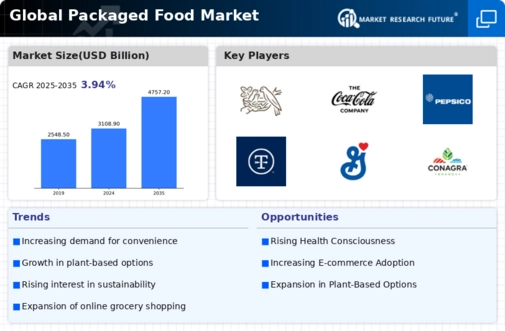Top Industry Leaders in the Packaged Food Market

Strategies Adopted by Packaged Food Key Players
The packaged food market is a dynamic and evolving sector that caters to the changing lifestyles and preferences of consumers globally. As the demand for convenient, ready-to-eat, and shelf-stable products continues to rise, the competitive landscape of the packaged food market is undergoing a transformation. This analysis explores key players, their strategies, market share factors, emerging companies, industry news, and current investment trends, providing a comprehensive overview of the competitive scenario.
Key Players and Market Dominance: At the forefront of the packaged food market, several key players dominate the industry, shaping its trajectory.
- Nestle
- The Coca-Cola Company
- PepsiCo
- Tyson Foods, Inc.
- Mars, Incorporated
- Cargill, Incorporated
- The Kraft Heinz Company
- General Mills Inc.
- Conagra Brands, Inc.
- Kellogg Co.
are among the giants that have established their dominance through a combination of brand recognition, extensive distribution networks, and diversified product portfolios. These industry leaders continually invest in research and development to innovate and introduce new products, ensuring their relevance in an ever-changing market.
Strategies Adopted by Market Leaders: Market leaders employ various strategies to maintain and expand their market share. Product innovation remains a key focus, with an emphasis on health and wellness, sustainability, and convenience. Additionally, strategic partnerships and acquisitions play a crucial role in expanding product portfolios and entering new markets. For instance, Nestlé's acquisition of Atrium Innovations and The Kraft Heinz Company's strategic partnership with Oprah Winfrey for a new line of nutritious products exemplify the proactive measures taken by industry leaders.
Factors Influencing Market Share Analysis: Several factors contribute to the market share analysis of packaged food companies. Consumer preferences and changing dietary habits are pivotal, as companies strive to align their offerings with health-conscious trends. The ability to adapt to cultural preferences and regional tastes also influences market share. Moreover, effective marketing and branding strategies, supply chain efficiency, and a strong retail presence contribute significantly to a company's competitive position. Data analytics and artificial intelligence are increasingly employed to gain insights into consumer behavior and preferences, enabling companies to tailor their products and marketing strategies accordingly.
New and Emerging Companies: While industry giants dominate, a wave of new and emerging companies is disrupting the packaged food market with innovative approaches and niche offerings. Start-ups like Beyond Meat and Impossible Foods have gained traction by tapping into the growing demand for plant-based alternatives. These companies prioritize sustainability, ethical sourcing, and clean-label products, appealing to a segment of consumers seeking healthier and environmentally conscious options. As these disruptors gain momentum, they pose a challenge to established players, prompting them to adapt and diversify their product lines.
Industry News and Current Trends: Keeping a pulse on industry news is crucial to understanding the ever-changing dynamics of the packaged food market. Ongoing trends include the rise of e-commerce, accelerated by the global shift to online shopping. Companies are investing in robust online platforms and digital marketing to enhance their reach and engage with consumers directly. Health and wellness continue to be at the forefront, with an increasing emphasis on clean labels, transparency, and nutritional benefits. The impact of the COVID-19 pandemic has also accelerated trends such as home cooking and the demand for immune-boosting products.
Current Company Investment Trends: Investment trends in the packaged food market reflect the industry's response to emerging challenges and opportunities. Companies are allocating significant resources to sustainability initiatives, including eco-friendly packaging and supply chain optimization to reduce environmental impact. Investments in technology, such as blockchain for supply chain transparency and data analytics for personalized marketing, are becoming increasingly prevalent. Moreover, strategic investments in emerging markets and partnerships with local players enable companies to tap into new consumer bases and diversify their revenue streams.
Overall Competitive Scenario: The overall competitive scenario in the packaged food market is marked by a delicate balance between established players defending their market share and nimble newcomers disrupting traditional norms. The industry's evolution is driven by a combination of consumer demands, technological advancements, and global events. Successful companies are those that can adapt swiftly, innovate continuously, and embrace sustainability and health-conscious trends. As the landscape continues to evolve, collaboration, strategic partnerships, and a commitment to meeting the evolving needs of consumers will be key to sustaining competitiveness in the dynamic world of packaged food.










